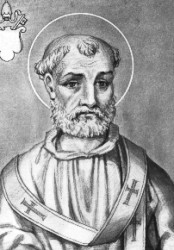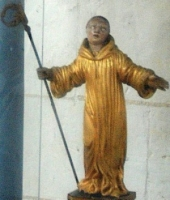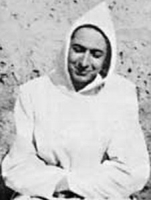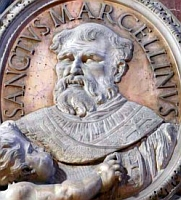St. Anacletus II
புனிதர் அனக்லேட்டஸ்
3ம் திருத்தந்தை:
பிறப்பு: கி. பி. 25
ரோம், இத்தாலி, ரோம பேரரசு
இறப்பு: ஏப்ரல் 26, 88
ரோம், இத்தாலி, ரோம பேரரசு
ஏற்கும் சமயம்:
ரோமன் கத்தோலிக்க திருச்சபை
நினைவுத் திருநாள்: ஏப்ரல் 26
புனிதர் அனக்லேட்டஸ் கத்தோலிக்க திருச்சபையின் மூன்றாம் திருத்தந்தையாவார். அவருக்கு முன் திருத்தந்தையராக இருந்தவர்கள் முதலில் "பேதுரு" (St. Peter), அதன்பின் "புனிதர் லைனஸ்" (Saint Linus) ஆவர். இவர் கத்தோலிக்க திருச்சபையால் புனிதராகக் மதிக்கப்படுகிறார்.
பதவிக் காலம் பற்றிய செய்திகள்:
மரபுச் செய்திகளின்படி, அனக்லேட்டஸ் ரோமைச் சார்ந்தவர் என்றும், பன்னிரு ஆண்டுகள் ஆட்சி செய்தார் என்றும் கூறப்படுகிறது. வத்திக்கான் வெளியிடுகின்ற "ஆண்டு ஏடு" (Annuario Pontificio), "முதல் இரு நூற்றாண்டுகளைப் பொறுத்தமட்டில், ஒரு குறிப்பிட்ட திருத்தந்தை எப்போது பதவி ஏற்றார், எப்போது அவரது பதவிக்காலம் முடிந்தது என்பது பற்றி உறுதியாகக் கூறுவது கடினம்" என்றுரைக்கிறது. அந்த ஏட்டின்படி, அனக்லேட்டஸ் கி.பி. 80 முதல் கி.பி. 92 வரை பதவியிலிருந்தார். வேறு சில ஏடுகள் அப்பதவிக்காலம் கி.பி. 77 முதல் கி.பி. 88 என்று கூறுகின்றன.
திருத்தந்தை அனக்லேட்டஸ் ரோம் மறைமாவட்டத்தை 25 பங்குத்தளங்களாகப் பிரித்தார் என்றும், ஒரு சிலரைக் குருக்களாகத் திருநிலைப்படுத்தினார் என்றும் சில பண்டைய ஏடுகள் கூறுகின்றன.
வத்திக்கானில் கல்லறை:
திருத்தந்தை அனக்லேட்டஸ் இன்றைய வத்திக்கான் நகரில் அமைந்துள்ள புனித பேதுரு பேராலயத்தில் அவருக்குமுன் பதவியிலிருந்த "திருத்தந்தை லைனஸ்" (Saint Linus) என்பவரின் கல்லறைக்கு அருகில் அடக்கம் செய்யப்பட்டுள்ளார். அனக்லேட்டஸ் என்னும் திருத்தந்தையின் பெயர் ரோம் வழிபாட்டு முறைத் திருப்பலியில் உள்ள நற்கருணை வழிபாட்டு வேண்டுதலில் சேர்க்கப்பட்டுள்ளது.
நினைவுத் திருவிழா:
கத்தோலிக்க திருச்சபையின் பழைய நாட்காட்டியாகிய "திரிதெந்தீன் நாட்காட்டியில்" ஏப்ரல் 26ஆம் நாள் புனித அனக்லேட்டஸ் மற்றும் புனித மார்செல்லீனுஸ் ஆகியோரின் விழா கொண்டாடப் பணிக்கப்பட்டது. அந்நாட்காட்டியில் ஜூலை 13ம் நாள் புனித அனக்லேட்டஸ் திருவிழா அமைந்தது.
1960ம் ஆண்டில் திருத்தந்தை இருபத்திமூன்றாம் யோவான் ஜூலை மாதம், 13ம் நாளில் இருந்த விழாவை அகற்றினார். அதே நேரத்தில், ஏப்ரல் மாதம், 26ம் நாள் புனித அனக்லேட்டஸ் விழாவாக அமையும் என்று பணித்தார். அனக்லேட்டஸ் என்னும் பெயர் ரோம் நற்கருணை வழிபாட்டு வேண்டுதலில் உள்ளது.
1969ம் ஆண்டு முதல் ஏப்ரல் 26 விழா கத்தோலிக்க திருச்சபையின் பொது நாள்காட்டியில் இல்லை. திருத்தந்தை அனக்லேட்டஸ் எந்த நாளில் இறந்தார் என்பது உறுதியாகத் தெரியாவிட்டாலும், "ரோம் மறைச்சாட்சியர் நூல்" (Roman Martyrology) என்னும் ஏடு, அவர் ஏப்ரல் மாதம், 26ம் நாள் இறந்ததாகக் குறிப்பிடுகிறது.
Feastday: April 26
Death: 88
Pope from 76 to 88 and martyr, the second successor to St. Peter. He died during the persecutions instituted by Emperor Domitian.
Pope Anacletus (died c. AD 92), also known as Cletus, was the bishop of Rome, following Peter, and Linus. Anacletus served between c. AD 79 and his death, c. AD 92. Cletus was a Roman who, during his tenure as pope, ordained a number of priests and is traditionally credited with setting up about twenty-five parishes in Rome.[1] Although the precise dates of his pontificate are uncertain, he "...died a martyr, perhaps about 91".[2] Cletus is mentioned in the Roman Canon of the mass; his feast day is April 26.
Name and etymology
The name "Cletus" (Ancient Greek: Κλητος, romanized: Klētos) means "one who has been called", and "Anacletus" (Ancient Greek: Ἀνάκλητος, romanized: Anaklētos) means "one who has been called back". Also "Anencletus" (Ancient Greek: Ἀνάγκλητος) means "unimpeachable" or "blameless".[3]
The Roman Martyrology mentions the pope as "Cletus".[4] The Annuario Pontificio gives both forms as alternatives. Eusebius, Irenaeus, Augustine of Hippo and Optatus all suggest that both names refer to the same individual.[2]
Papacy
As with much of the earlier papacy, little is known of Anacletus' pontificate. Earlier historical records are inconsistent in their usage of the names Cletus, Anacletus, and Anencletus and in the placement of these names in the order of succession. Generally, the order used by Irenaeus is used today, wherein Cletus and Anencletus refer to the same person, who succeeded Linus and preceded Clement.[2] Traditionally, it was accepted that he reigned for twelve years, though the dates of that reign are questionable. The Annuario Pontificio states, "For the first two centuries, the dates of the start and the end of the pontificate are uncertain", before placing Anacletus' pontificate from AD 80 to AD 92.[1] However, AD 76 to AD 88 are also frequently cited.[1][5]
According to tradition, Pope Anacletus divided Rome into twenty-five parishes. One of the few surviving records concerning his papacy mentions him as having ordained an uncertain number of priests.[2]
Pope Anacletus was martyred, ending his pontificate.[2] A tomb ascribed to Anacletus is located near St Peter's tomb in the Vatican Necropolis field P, underneath St Peters Basilica. This tomb is located with tombs ascribed to Linus, Evaristus, Telesphorus, Hyginus, Pius I, Anicetus, and Victor I. Little epigraphic evidence exists to support the ascription of these tombs to the early popes.[6] His name (as Cletus) is included in the Roman Canon of the Mass.
Veneration
Statue of Pope Anacletus, from Church of San Cleto, in Rome
The Tridentine Calendar reserved 26 April as the feast day of Saint Cletus, who the church honoured jointly with Pope Marcellinus, and 13 July for solely Saint Anacletus. In 1960, Pope John XXIII, while keeping the 26 April feast, which mentions the saint under the name given to him in the Canon of the Mass, removed 13 July as a feast day for Saint Anacletus. The 14 February 1961 Instruction of the Congregation for Rites on the application to local calendars of Pope John XXIII's motu proprio Rubricarum instructum of 25 July 1960, decreed that "the feast of 'Saint Anacletus', on whatever ground and in whatever grade it is celebrated, is transferred to 26 April, under its right name, 'Saint Cletus'". Priests who celebrate Mass according to the General Roman Calendar of 1954 keep the July 13th feastday; but the feast has been removed from the General Roman Calendar since 1960, and as such is not kept even in the 1962 Missal.[7] Although the day of his death is unknown,[7] Saint Cletus continues to be listed in the Roman Martyrology among the saints of 26 April.[8]
St. Exuperantia
Feastday: April 26
Death: unknown
A virgin of Troyes, France. She is venerated there, but no details of her life are extant.
Our Lady of Good Counsel
Also known as
• La Madonna del Paradiso
• Madonna del Buon Consiglio
Additional Memorial
25 April at Genazzano, Italy
Profile
Records dating from the reign of Paul II relate that the picture of Our Lady, at first called La Madonna del Paradiso and now better known as Madonna del Buon Consiglio, appeared at Genazzano, Italy, a town about twenty-five miles southeast of Rome, on 25 April 1467, in the old church of Santa Maria, which had been under the care of Augustinians since 1356. The venerated icon itself, which is drawn on a thin scale of wall-plaster little thicker than a visiting-card, was observed to hang suspended in the air without support; early tradition says that one could pass a thread around the image without touching it. Devotion to Our Lady in Santa Maria sprang up at once. Pilgrims began to pour in, miracles began and continue at the shrine.
In July 1467, Pope Paul deputed two bishops to investigate the alleged wonder-working image; no copy of their report is known to have survived. Devotion to Our Lady increased. In 1630, Pope Urban VIII made a pilgrimage to Genazzano, as did Pope Blessed Pius IX in 1864. On 17 November 1682 Pope Blessed Innocent XI had the picture crowned with gold by the Vatican Basilica. In 1727 Pope Benedict XIII granted the clergy of Genazzano an Office and Mass of Our Lady for 25 April, the anniversary of the apparition, elsewhere the feast being kept a day later so as not to conflict with that of Saint Mark the Evangelist. On 2 July 1753 Pope Benedict XIV approved the Pious Union of Our Lady of Good Counsel for the faithful at large, and himself enrolled therein as its pioneer member; Pope Pius IX and Pope Leo XIII were both later members. On 18 December 1779, Pope Pius VI, while re-approving devotion to Our Lady, granted all Augustinians an Office with hymns, lessons, prayer and Mass proper of double-major rite; with a plenary indulgence also for the faithful, to which Pope Pius VIII added another for visitors to the shrine. On 18 December 1884, Pope Leo XIII approved of a new Office and Mass of second-class rite for all Augustinians, while on 17 March 1903, he elevated the church of Santa Maria - one of the four parish churches in tiny Genazzano - to the rank of minor basilica. On 22 April 1903 he authorized the insertion in the Litany of Loreto of the invocation Mater Boni Consillii to follow that of Mater Admirabilis. The same pontiff on 21 December 1893 had sanctioned the use of the White Scapular of Our Lady of Good Counsel for the faithful.
Saint Paschasius Radbertus
Also known as
• Radbertus
• Paschasius Radbert
Profile
A foundling whose background is completely unknown. Raised by monks after being found by nuns on the steps of Notre Dame of Soissons. Unruly in his youth, even with the brothers. Benedictine monk under Saint Adalard of Corbie. Deacon. Teacher. Moved to Corbie Abbey in 822, and helped make its school at one of the most famous places of learning in its day. Spiritual teacher of Saint Ansgar. Paschasius travelled Europe, speaking at councils, negotiating political and religious conflicts.
Against his will he was elected abbot of the Corbie in 844. During undescribed trouble in the monastery in 851, he resigned his position to settle the dispute. He retired as a hermit to the Saint Riquiet monastery in Cenula where he spent the rest of his life writing on history, philosophy, and theology. His The Body and Blood of Christ started the first controversy on the Eucharist, and cleared the way for a precise understanding of Transubstantiation.
Born
c.790 at Soissons, France
Died
• c.860 of natural causes
• buried in the church of Saint John at Corbie Abbey
• relics re-interred at Saint Peter's church at Corbie on 12 July 1073
Blessed Wladyslaw Goral
Also known as
Ladislao Goral
Profile
Ordained on 18 December 1920. Auxiliary bishop of Lublin, Poland and titular bishop of Meloë in Isauria on 10 August 1938. He was a man known for his devotion to the Church, and for his ascetic life in a modern setting. During the Nazi invasion in World War II, he was arrested by the Gestapo in November 1939 and sentenced to death for being a priest; the Vatican intervened and the sentence was commuted to life imprisonment. Father Wladyslaw was sent to the Sachsenhausen concentration camp and kept in an isolated bunker, away from other prisoners, neglected and abuse for years until he died shortly before the camp was liberated. Martyr.
Born
1 May 1898 in Stoczek, Lubelskie, Poland
Died
April 1945 in Sachsenhausen-Oranienburg, Oberhavel, Germany of unspecified diseases following years of neglect
Beatified
13 June 1999 by Pope John Paul II
Saint Richarius of Celles
Also known as
Ricario, Riquier
Additional Memorial
9 October (translation of relics)
Profile
Born a pagan. As a young man he protected Cadoc and Frichor, Irish missionaries in danger from local non-Christians. While in hiding, the missionaries converted Richardius. He became a priest, travelling the country on a donkey and preaching the Gospel. Worked in England for several years, then returned to France to found an abbey at Centula and serve as its first abbot. When King Dagobert visited him, Richarius was so frank and blunt with his advice that the king gave him a large reward; Richarius passed it on to the poor. He was among the first to work on ransoming captives. Eventually resigned all offices to live his final years as a prayerful hermit.
Born
at Centula, France
Died
• 26 April 645 at Foret-Moutier, France of natural causes
• initially buried in a hollowed-out tree because that's all his disciple Sigobart could afford
Saint Rafael Arnáiz Barón
Also known as
María Rafael
Profile
An artistic young man, he studied architecture in Madrid, Spain. However, he felt a call to the religious life, and on 15 April 1934 Rafael became an oblate friar of the Order of Cistercians of the Strict Observance (Trappist). Suffered from acute diabetes, a condition that forced him to leave the monastery three times, but each time, as soon as he was sufficiently healed, he returned to the monastic life.
Born
9 April 1911 in Burgos, Spain
Died
26 April 1938 in Dueñas, Palencia, Spain
Canonized
11 October 2009 by Pope Benedict XVI
Blessed Stanislaw Kubista
Also known as
• Stanislaus Kubista
• prisoner 21154
Profile
One of nine children born to Francis and Frances Kubista. Served in the army on the French front from 1917 to 1919. Member of the Society of Divine Word, making his perpetual vows on 29 September 1926. Ordained on 26 May 1927. Middle school teacher. Novice master and spiritual director. Built and ran a printing press, edited and published Little Missionary, Little Missionary Calendar, Calendar of the Word of God, Messenger of Saint Joseph and other works. Arrested on 27 October 1939 by Nazis, transferred from prison to prison until he arrived at the Sachsenhausen concentration camp. Martyr.
Born
27 September 1898 in Kostuchna, Slaskie, Poland
Died
26 April 1940 in Sachsenhausen-Oranienburg, Oberhavel, Germany
Beatified
13 June 1999 by Pope John Paul II
Blessed Juli Junyer Padern
Also known as
Julius, Julio
Profile
Salesian, making his profession in 1912. Ordained in 1921. Taught philosophy, literature and Gregory chant in Girona, Spain, and served as spiritual director to other Salesians. Arrested by anti-Catholic forces in 1938, but was released. Helped some other Salesians escape across the border, which led to Father Juli's re-arrest for treason and espionage. Martyred in the Spanish Civil War.
Born
30 October 1892 in Vilamaniscle, Girona, Spain
Died
shot at 7am on 26 April 1938 in the moat of Montjuic Castle, Barcelona, Spain
Beatified
11 March 2001 by Pope John Paul II
Pope Saint Marcellinus
புனிதர் மர்செல்லீனஸ்
29ம் திருத்தந்தை:
பிறப்பு: தெரியவில்லை
ரோம், மேற்கு ரோமப் பேரரசு
இறப்பு: கி.பி. 304
ரோம், மேற்கு ரோமப் பேரரசு
நினைவுத் திருநாள்: ஏப்ரல் 26
திருத்தந்தை மர்செல்லீனஸ், ரோம் ஆயராகவும், திருத்தந்தையாகவும் 296ம் ஆண்டு, ஜூன் மாதம், 30ம் நாள் முதல், கி.பி. 304ம் ஆண்டு, அக்டோபர் மாதம், 25ம் நாள்வரை ஆட்சி செய்தார். இவருக்கு முன் திருத்தந்தையாக இருந்தவர் “காயுஸ்” (Pope Caius) என்பவர் ஆவார். திருத்தந்தை புனித மர்செல்லீனஸ் கத்தோலிக்க திருச்சபையின் 29ம் திருத்தந்தை ஆவார். மர்செல்லீனஸ் என்பது பண்டைய உரோமைக் குடும்பப் பெயர்களுள் ஒன்றாகும்.
ரோமப் பேரரசன் (Roman Emperor) “டையோக்ளேசியன்” (Diocletian) ஆண்ட காலத்தில் மர்செல்லீனஸ் திருத்தந்தையாகப் பொறுப்பேற்றார். அப்போது கிறிஸ்தவர்கள் தம் மதத்தைச் சுதந்திரமாகக் கடைப்பிடித்தனர். அவர்களின் எண்ணிக்கையும் உயர்ந்தது.
ஆனால் கி.பி. 302ம் ஆண்டு, மன்னனன் டையோக்ளேசியன் கிறிஸ்தவர்களைத் துன்புறுத்தத் தொடங்கினார். கிறிஸ்தவப் போர்வீரர்கள் படையிலிருந்து விலக்கப்பட்டனர். பின்னர் கிறிஸ்தவர்களின் சொத்துக்கள் பறிக்கப்பட்டன. அவர்களுடைய நூல்களும் அழிக்கப்பட்டன. மன்னனின் அரண்மனை இரு முறை தீப்பற்றி எரிந்ததும், மன்னனின் செயல்பாடு இன்னும் அதிகக் கொடூரமானது. கிறிஸ்தவத்தைக் கைவிடாவிட்டால் சாவுதான் முடிவு என்றாயிற்று.
இந்த நெருக்கடியின்போது, மர்செல்லீனஸ் விவிலியம் மற்றும் கிறிஸ்தவ சமய நூல்களை மன்னனின் ஆணைக்கு ஏற்ப கையளித்தார் என்றும், கிறிஸ்தவ நம்பிக்கையை விட்டு விலகினார் என்றும், பின்னர் மனம் வருந்தி கிறிஸ்தவத்துக்குத் திரும்பினார் என்றும், அதன் பொருட்டு மறைச்சாட்சியாக உயிர்துறந்தார் என்றும் திருத்தந்தையர் நூல் (Liber Pontificalis) கூறுகிறது. அச்செய்தி தற்போது கைவசம் கிடைக்காத "புனித மர்செல்லீனசின் சாவு வரலாறு" (Acts of St. Marcellinus) என்னும் பண்டைய ஏட்டிலிருந்து பெறப்பட்டது.
திருத்தந்தை மர்செல்லீனுஸ் கி.பி. 304ம் ஆண்டு ஏப்ரல் மாதம், 26ம் நாள், அவர் இறந்து 25 நாள்களுக்குப் பின், ரோம் சலாரியா சாலையில் உள்ள பிரிசில்லா கல்லறைத் தோட்டத்தில் அடக்கம் செய்யப்பட்டார். இச்செய்தி திருத்தந்தையர் நூலில் உள்ளது.
கி.பி. 13ம் நூற்றாண்டில் மர்செல்லீனஸ் நினைவாக விழாக் கொண்டாடப்பட்டது. ஏப்ரல் 26ம் நாள் அவருடைய விழா புனிதர் கிலேட்டஸ் (Saint Cletus) விழாவோடு இணைத்துக் கொண்டாடப்பட்டது. ஆனால் இந்த இரு திருத்தந்தையரின் மறைச்சாட்சிச் சாவு பற்றியும் வரலாற்றுத் தெளிவு இல்லாமையால் 1969ம் ஆண்டு வெளியான புனிதர் நாள்காட்டியில் அவ்விழா குறிக்கப்படவில்லை.
வழிவந்த திருத்தந்தை:
மர்செல்லீனசின் மரணத்தின் பிறகு, கிறிஸ்தவ சபை துன்புறுத்தப்பட்ட நிலையில் இருந்ததால், சுமார் நான்கு ஆண்டுகளுக்குப் பின்னரே புதிய திருத்தந்தை தேர்ந்தெடுக்கப்பட்டார். அவர் பெயர் முதலாம் மர்செல்லஸ் (Pope Marcellus) ஆகும்.
Profile
Chosen 29th pope. Enlarged the catacombs. Reigned at the start of the persecution of Diocletian, and was himself martyred. Legend says that he apostatized, made sacrifice to pagan gods, then repented, and was beheaded, but this story has been discredited.
Born
at Rome, Italy
Papal Ascension
30 June 296
Died
• 25 October 304 at Rome, Italy
• interred in the Priscillian catacomb on the Via Salaria
Saint Trudpert of Münstertal
புனிதர் ட்ரூட்பெர்ட்
மறைப்பணியாளர்:
பிறப்பு:
அயர்லாந்து அல்லது ஜெர்மனி
இறப்பு: கி.பி. 607 அல்லது கி.பி. 644
ஏற்கும் சமயம்:
ரோமன் கத்தோலிக்க திருச்சபை
கிழக்கு மரபுவழி திருச்சபை
நினைவுத் திருநாள்: ஏப்ரல் 26
ஏழாம் நூற்றாண்டில் பிறந்த புனிதர் ட்ரூட்பெர்ட், ஜெர்மனி நாட்டின் ஒரு மதபோதகர் ஆவார். இவர் அயர்லாந்தின் "செல்டிக்" துறவி (Celtic monk) என்றும் அழைக்கப்பட்டார். இவர் மறைபரப்பு பணியை தொடர்ந்து செய்ய, திருத்தந்தையின் அதிகாரம் பெற ரோம் சென்றார். அங்கிருந்து மீண்டும் ஜெர்மனிக்கு திரும்பி வர "ப்ரெய்ஸ்கவ்" (Breisgau) நாட்டிலுள்ள "ஆலமன்னி" (Alamanni) வழியாக பயணித்து நாடு திரும்பினார். அப்போது ரைனி'ல் (Rhine) பயணம் செய்யும்போது, ஃப்ரைபர்க்-ஐ (Freiburg) சேர்ந்த ஒருவர் தன்னிடம் இருந்த நிலத்தில், சுமார் 25 கிலோமீட்டர் நிலத்தை, மறைபரப்பு பணிக்காக கொடுத்தார்.
அப்போது ட்ரூட்பெர்ட், அந்நிலத்திலிருந்த மரம் புதர்களை அழித்துவிட்டு, ஒரு சிறு அறையையும் சிறிய தேவாலயம் ஒன்றையும் கட்டினார். பின்னாளில், "கான்ஸ்டன்ஸ்" மறை மாவட்ட ஆயரான "மார்ட்டினஸ்" (Bishop Martinus of Constance) இந்த தேவாலயத்தை புனிதர்கள் பீட்டர் மற்றும் பவுல் ஆகியோருக்கு அர்ப்பணித்தார்.
அங்கே ஓர் வேலையாள் போலவே, துறவி ட்ரூட்பெர்ட் உழைத்தார். ஒரு நாள் வேலை முடித்துவிட்டு களைப்பாக உறங்கும்போது, முன்பின் தெரியாத, அடிமைகளின் வகுப்பைச் சேர்ந்த ஒருவர் வந்து அவரை கொன்றுவிட்டான். பின்னர் ஓட்பெர்க் (Otbert) என்பவர், ட்ரூட்பெர்ட்'டை கௌரவமாக அடக்கம் செய்தார். இவர் வாழ்ந்த குறுகிய காலத்தில் குழந்தைப் பருவத்திலிருந்தே எண்ணிலடங்கா, பணிகளைச் செய்துள்ளார். அவர் கி.பி. 640 முதல் கி.பி. 643 வரை ப்ரெய்ஸ்கவ்-இல் வாழ்ந்தார் என்று வரலாறு கூறுகின்றது. ஆனால் இவ்வாண்டுகளில் அங்கே வாழ்ந்த பவர் (Baur) என்பவர் ட்ரூட்பெர்ட் 607ம் ஆண்டு, இறந்து விட்டார் என்று கூறியுள்ளார்.
அதன்பிறகு கி.பி. 815ம் ஆண்டு அவரின் எலும்புகள் கண்டுபிடிக்கப்பட்டது. அவர் வாழும்போது எழுதிய அவரின் வாழ்க்கை வரலாற்றை 10 மற்றும் 13ம் நூற்றாண்டுகளில் கண்டுபிடிக்கப்பட்டு, அதை சரிசெய்து பாதுகாக்கப்படுகின்றது. முன்ஸ்டர் (Münster) நகரில் உள்ள ஆசீர்வாதப்பர் மடத்தில் இவரது எலும்புகளும், வரலாற்று ஆவணங்களும் வைக்கப்பட்டது. அங்கு இப்புனிதருக்கென்று பேராலயமும் உள்ளது.
இப்புனிதர் அடக்கம் செய்யப்பட்ட இடத்தில், அவர் பெயரில் ஒரு "பெனடிக்டைன் மடம்" (Benedictine Abbey of St. Trudpert) கட்டப்பட்டது.
Also known as
Trudbert, Trupbertus
Profile
Abbot. Following a pilgrimage to Rome, he became a missionary hermit at Münstertal, Germany. Legend says that some workers, paid by a local lord to clear difficult land to establish a foundation for Trudpert, were fed up with the hard work and killed Trudpert to end the job. Considered a martyr.
Died
• c.644 at Münstertal, Germany
• the Kloster Sankt Trudpert was built on the site of his death
Blessed Dominic of Besians
Profile
Spanish Dominican. With Blessed Gregory, he preached in the villages of the Somontano, near Barbastro, near the Spanish Pyrenees. While travelling from one village to another, they were caught in strong thunderstorm; they sought refuge under and overhanging rock, which was loosened by the rain, and fell on them.
Born
Spain
Died
• crushed by a boulder in 1300 at Perarrúa, Spain
• relics at Besians, diocese of Barbastro, Spain
Beatified
by Pope Pius IX (cultus confirmed)
Blessed Gregory of Besians
Profile
Spanish Dominican. With Saint Dominic, he preached in the villages of the Somontano, near Barbastro, near the Spanish Pyrenees. While travelling from one village to another, they were caught in strong thunderstorm; they sought refuge under and overhanging rock, which was loosened by the rain, and fell on them.
Born
Spain
Died
• crushed by a boulder in 1300 at Perarrúa, Spain
• relics at Besians, diocese of Barbastro, Spain
Beatified
by Pope Pius IX (cultus confirmed)
Blessed Alda of Siena
புனித_ஆல்தோ (1249-1309)
ஏப்ரல் 26
இவர் (#StAldoOfSiena) இத்தாலியில் உள்ள சியென்னாவில் பிறந்தவர்.
திருமணமாகி ஒருசில மாதங்களிலேயே இவர் தன்னுடைய கணவரை இழந்தார். இதன்பிறகு இவர் தன் உடைமைகளையெல்லாம் விற்று, ஏழைகளுக்குக் கொடுத்துவிட்டு, சியென்னா நகருக்கு வெளியே ஒரு குடிசை அமைத்து நோன்பிருந்தார்.
சில காலம் இப்படி நோன்பிருந்த இவர், மருத்துவமனையில் உள்ள நோயாளர்களுக்கு உதவி செய்தால் நன்றாக இருக்கும் என்று முடிவு செய்து, அதன்படி மருத்துவமனையில் உள்ளவர்களுக்கு உதவி செய்தார்.
இறைவன் இவரோடு இருந்ததால், இவர் யார் மீதெல்லாம் சிலுவை அடையாளம் வரைந்து மன்றாடினாரோ, அவர்கள் எல்லாரும் விரைவில் நலம்பெற்றார்கள்.
இதனால் இவருடைய புகழ் எங்கும் பரவியது. இது ஏற்கெனவே மருத்துவமனையில் பணிசெய்து வந்தவர்களுக்குப் பிடிக்கவில்லை. அவர்கள் இவர்மீது கொண்ட பொறாமையால், இவரைக் குண்டூசியால் குத்தித் துன்புறுத்தினார்கள். அவற்றையெல்லாம் இவர் பொறுத்துக் கொண்டது மட்டுமல்லாமல், அவர்களை மனதார மன்னித்தார்.
இப்படி இவர் நோயாளர்கள் நடுவில் பணிசெய்யும் போதே இவர் உயிர் பிரிந்தது.
Also known as
Aldobrandesca, Aude, Blanca, Bruna
Profile
Married lay woman. Widow. Tertiary of the Holy Humility of Mary. She devoted her life to personal penance and charity to the poor, was given to religious ecstasies, and received visions. Greatly honoured in Siena, Italy.
Born
1249 at Siena, Italy
Died
1309
Saint Basileus of Amasea
Also known as
Basil, Basilius
Profile
Bishop of Amasea in Pontus. When he was killed in the Licinius persecutions by being thrown into the sea to drown, one of his disciples was directed to his body by an angel so it could be recovered and given Christian burial.
Died
drowned in 319
Saint Exuerantia of Troyes
Also known as
Esperance, Exuperance, Exuperantia
Profile
Nun. Her relics are venerated in Troyes, France.
Died
c.380 of natural causes
Saint Antoninus of Rome
Profile
Martyred in the persecutions of Diocletian. Mentioned in the Acts of Saint Marcellinus, Pope and Martyr.
Died
beheaded
Saint Claudius of Rome
Profile
Martyred in the persecutions of Diocletian. Mentioned in the Acts of Saint Marcellinus, Pope and Martyr.
Died
beheaded
Saint Cyrinus of Rome
Profile
Martyred in the persecutions of Diocletian. Mentioned in the Acts of Saint Marcellinus, Pope and Martyr.
Died
beheaded
Saint Lucidius of Verona
Profile
Fourth century bishop of Verona, Italy. Famous for a life of prayer and study.
Saint Primitive of Gabi
Profile
Martyr.
Died
Via Prenestina outside Rome, Italy
Saint Pellegrino of Foggia
Profile
Hermit at Foggia, Italy.
Saint Clarence of Venice
Profile
Bishop of Venice, Italy.
Saint Peter of Braga
Profile
First bishop of Braga, Portugal. Martyr
Saint William of Foggia
Profile
Hermit at Foggia, Italy.
Indreachtach of Bangor
Indreachtach of Bangor was a 9th-century abbot commemorated on April 26th. Here's what we know about him:
Time Period: Lived in the 9th century and died around the beginning of the 10th century.
Title: Abbot of Bangor, likely referring to Bangor Abbey in County Down, Ireland.
Commemoration: Celebrated on April 26th according to some sources like "Omnium Sanctorum Hiberniae".
Details: Information about his life and accomplishments as Abbot is scarce.
Some sources like the Martyrology of Tallagh might not include him due to its compilation date being before his death.
Stephen of Perm
Stephen of Perm, also known as Saint Stephen of Perm, was a highly influential figure in the 14th century. Here's a breakdown of his life and achievements:
Life and Work:
Lived: Born around 1340 in Veliky Ustyug, Russia - Died in 1396 (age 56)
Occupation: Russian Orthodox bishop, missionary, painter
Known for: Spreading Christianity among the Komi people (formerly known as Zyrians) in western Perm. He's considered the "Enlightener of Perm" and "Apostle to the Zyrians."
Accomplishments:
Developed the Old Permic script, laying the foundation for written Permian language.
Translated religious texts into the Komi language, making religious teachings more accessible.
Established churches and schools, promoting education and religious conversion.
Became the first Bishop of Perm in 1383.
Legacy:
Saint Stephen is venerated as a saint in the Eastern Orthodox Church, with a feast day celebrated on April 26th.
His efforts significantly influenced the spread of Christianity and literacy among the Komi people.
He's remembered as a dedicated missionary who played a crucial role in cultural and religious development in the Perm region.












No comments:
Post a Comment